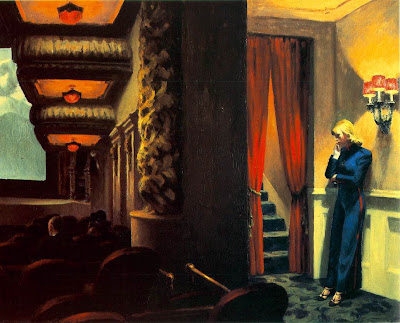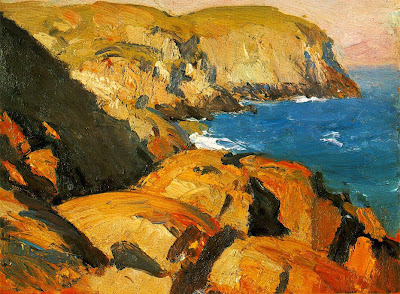
































He was born in the small Hudson River town of Nyack, New York State, on 22 July 1882. His family were solidly middle-class: his father owned a dry goods store where the young Hopper sometimes worked after school. By 1899 he had already decided to become an artist, but his parents persuaded him to begin by studying commercial illustration because this seemed to offer a more secure future. He first attended the New York School of Illustrating (more obscure than its title suggests), then in 1900 transferred to the New York School of Art. Here the leading figure and chief instructor was William Merritt Chase (1849-1916), an elegant imitator of Sargent. He also worked under Robert Henri (1869-1929), one of the fathers of American Realism - a man whom he later described as 'the most influential teacher I had', adding 'men didn't get much from Chase; there were mostly women in the class.' Hopper was a slow developer - he remained at the School of Art for seven years, latterly undertaking some teaching work himself. However, like the majority of the young American artists of the time, he longed to study in France. With his parents' help he finally left for Paris in October 1906. This was an exciting moment in the history of the Modern movement, but Hopper was to claim that its effect on him was minimal:
Whom did I meet? Nobody. I'd heard of Gertrude Stein, but I don't remember having heard of Picasso at all. I used to go to the cafés at night and sit and watch. I went to the theatre a little. Paris had no great or immediate impact on me.
"In addition to spending some months in Paris, he visited London, Amsterdam, Berlin and Brussels. The picture that seems to have impressed him most was Rembrandt's The Night Watch (in the Rijksmuseum, Amsterdam). Hopper was able to repeat his trip to Europe in 1909 and 1910. On the second occasion he visited Spain as well as France. After this, though he was to remain a restless traveller, he never set foot in Europe again. Yet its influence was to remain with him for a long time: he was well read in French literature, and could quote Verlaine in the original, as his future wife discovered (he was surprised when she finished the quotation for him). He said later: '[America] seemed awfully crude and raw when I got back. It took me ten years to get over Europe.' For some time his painting was full of reminiscences of what he had seen abroad. This tendency culminates in Soir Bleu of 1914, a recollection of the Mi-Caréme carnival in Paris, and one of the largest pictures Hopper ever painted. It failed to attract any attention when he showed it in a mixed exhibition in the following year, and it was this failure which threw him back to working on the American subjects with which his reputation is now associated. In 1913 Hopper made his first sale - a picture exhibited at the Armory Show in New York which brought together American artists and all the leading European modernists. In 1920 he had his first solo exhibition, at the Whitney Studio Club, but on this occasion none of the paintings sold. He was already thirty-seven and beginning to doubt if he would achieve any success as an artist - he was still forced to earn a living as a commercial illustrator. One way round this dilemma was to make prints, for which at that time there was a rising new market. These sold more readily than his paintings, and Hopper then moved to making watercolours, which sold more readily still.
"Hopper had settled in Greenwich Village, which was to be his base for the rest of his life, and in 1923 he renewed his friendship with a neighbour, Jo Nivison, whom he had known when they were fellow students under Chase and Henri. She was now forty; Hopper was forty-two. In the following year they married. Their long and complex relationship was to be the most important of the artist's life. Fiercely loyal to her husband, Jo felt in many respects oppressed by him. In particular, she felt that he did nothing to encourage her own development as a painter, but on the contrary did everything to frustrate it. 'Ed,' she confided to her diary, 'is the very centre of my universe... If I'm on the point of being very happy, he sees to it that I'm not.' The couple often quarrelled fiercely (an early subject of contention was Jo's devotion to her cat Arthur, whom Hopper regarded as a rival for her attention). Sometimes their rows exploded into physical violence, and on one occasion, just before a trip to Mexico, Jo bit Hopper's hand to the bone. On the other hand, her presence was essential to his work, sometimes literally so, since she now modelled for all the female figures in his paintings, and was adept at enacting the various roles he required.
"From the time of his marriage, Hopper's professional fortunes changed. His second solo show, at the Rehn Gallery in New York in 1924, was a sell-out. The following year, he painted what is now generally acknowledged to be his first fully mature picture, The House by the Railroad. With its deliberate, disciplined spareness, this is typical of what he was to create thereafter. His paintings combine apparently incompatible qualities. Modern in their bleakness and simplicity, they are also full of nostalgia for the puritan virtues of the American past - the kind of quirky nineteenth-century architecture Hopper liked to paint, for instance, could not have been more out of fashion than it was in the mid-192OS, when he first began to look at it seriously. Though his compositions are supposedly realist they also make frequent use of covert symbolism. Hopper's paintings have, in this respect, been rather aptly compared to the realist plays of Ibsen, a writer whom he admired.
"One of the themes of The House by the Railroad is the loneliness of travel, and the Hoppers now began to travel widely within the United States, as well as going on trips to Mexico. Their mobility was made possible by the fact that they were now sufficiently prosperous to buy a car. This became another subject of contention between the artist and his wife, since Hopper, not a good driver himself, resisted Jo's wish to learn to drive too. She did not acquire a driving licence until 1936, and even then her husband was extremely reluctant to allow her control of their automobile.
"By this time Hopper, whose career, once it took off, was surprisingly little affected by the Depression, had become extremely well known. In 1929, he was included in the Museum of Modern Art's second exhibition, Paintings by Nineteen Living Americans, and in 1930 The House by the Railroad entered the museum's permanent collection, as a gift from the millionaire collector Stephen Clark. In the same year, the Whitney Museum bought Hopper's Early Sunday Morning, its most expensive purchase up to that time. In 1933 Hopper was given a retrospective exhibition at the Museum of Modern Art. This was followed, in 1950, by a fuller retrospective show at the Whitney.
"Hopper became a pictorial poet who recorded the starkness and vastness of America. Sometimes he expressed aspects of this in traditional guise, as, for example, in his pictures of lighthouses and harsh New England landscapes; sometimes New York was his context, with eloquent cityscapes, often showing deserted streets at night. Some paintings, such as his celebrated image of a gas-station, Gas (1940), even have elements which anticipate Pop Art. Hopper once said: 'To me the most important thing is the sense of going on. You know how beautiful things are when you're travelling.'
"He painted hotels, motels, trains and highways, and also liked to paint the public and semi-public places where people gathered: restaurants, theatres, cinemas and offices. But even in these paintings he stressed the theme of loneliness - his theatres are often semideserted, with a few patrons waiting for the curtain to go up or the performers isolated in the fierce light of the stage. Hopper was a frequent movie-goer, and there is often a cinematic quality in his work. As the years went on, however, he found suitable subjects increasingly difficult to discover, and often felt blocked and unable to paint. His contemporary the painter Charles Burchfield wrote: 'With Hopper the whole fabric of his art seems to be interwoven with his personal character and manner of living.' When the link between the outer world he observed and the inner world of feeling and fantasy broke, Hopper found he was unable to create.
"In particular, the rise of Abstract Expressionism left him marooned artistically, for he disapproved of many aspects of the new art. He died in 1967, isolated if not forgotten, and Jo Hopper died ten months later. His true importance has only been fully realized in the years since his death."
- Text from "Lives of the Great 20th-Century Artists", by Edward Lucie-Smith



No comments:
Post a Comment